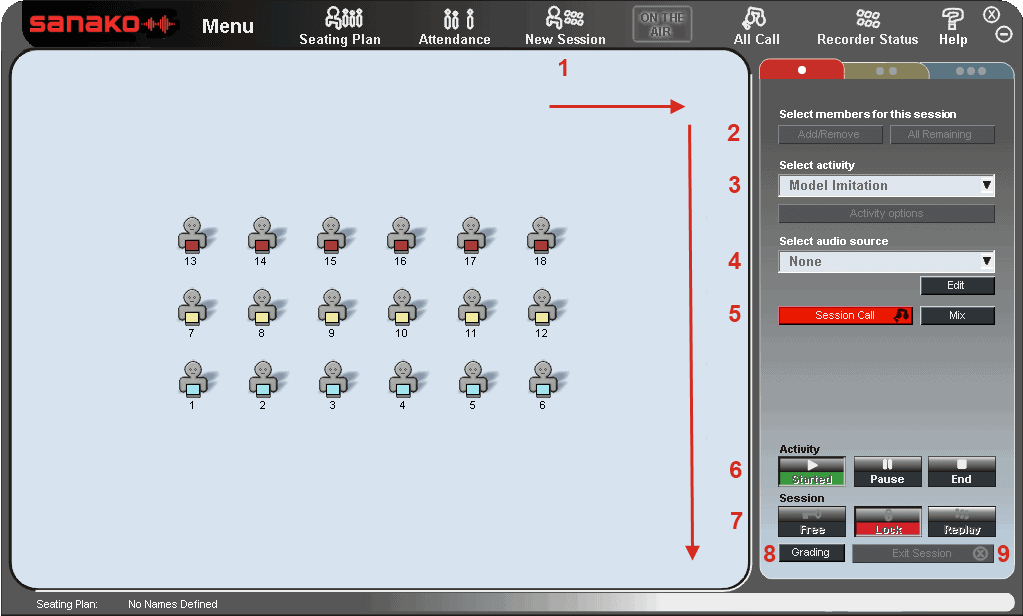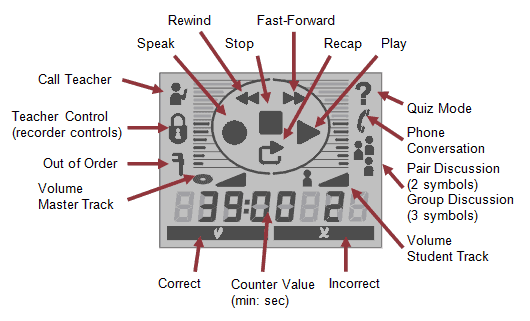Teachers: Using Lab 100 – step-by-step

1. Create a session
2. Select students for the session
3. Select activity
4. Select audio source
5. Call session to give instructions
6. Start/Pause/Continue/End activity
7. Free/Lock the student audio panels
8. Evaluate students’ performance by giving them grades and written comments
9. Exit session
Students: User Audio Panel
Playback functions

Function buttons

Lab 100 activities
LISTENING COMPREHENSION
Students listen to questions on the master track and then respond to them in order to develop their listening skills. You may allow students access to their recorders, so that they can work with the source individually, at their own pace. During or after listening to the source, you can “call” the session and select a student to answer questions.
MODEL IMITATION
By listening to a model audio and repeating after, the students practice the stress, rhythm and intonation of the foreign language. You can use yourself or a student as the model audio for the session. You can allow the students to access their recordings, and monitor and comment on their individual work.
READING PRACTICE
Students read aloud and listen to their input to practice the pronunciation and intonation and if allowed, students can work individually, at a speed they are comfortable with. The students can listen to and record their readings all over again.
PHONE CONVERSATION
Students practice speaking on the phone, by calling each other through their audio panels. You can monitor and comment the students’ work, and allow or disallow student access to their recorders, if appropriate.
PAIR DISCUSSION
In pairs, students develop their rhetorical skills through different oral exercises. They can focus on using their own words instead of fixed structures, and learn together at a speed they are comfortable with. You can select the pairs yourself or have the program make up fixed or random pairs for you.
GROUP DISCUSSION
Working in groups, the students can practice speaking skills through role plays as they express ideas and opinions, and defend a point of view. Students can, for instance, learn to understand and react appropriately in situations where intercultural communication is involved. Setting up groups is quick and easy and you may change the groupings at any time.
SIMULTANEOUS INTERPRETING
You will select an audio source that the students interpret simultaneously into their native language. For example, you can select yourself as the audio source and read the students aloud. Students interpret as you read, and the student input is recorded for later evaluation. You can allow the students listen to and rerecord their input, and monitor them as they practice.
CONSECUTIVE INTERPRETING
Consecutive interpreting means that the source is interpreted into another language in sections. The speaker stops at the end of every ‘paragraph’, and the interpreter then interprets what was said. You may allow students to rerecord their input individually and monitor them as they practice.
RECORDED RESPONSE
Ideal for training intercultural communication through situational exercises. For example, students simulate a job interview with a prerecorded source and focus on reacting appropriately.
QUIZ
The Lab 100 Quiz is a quick and easy way to see how well the students answer the questions you make. You access the test response modes and immediately get an indication of the effectiveness of your teaching and retention of the concept.
AP® EXAM
With Lab 100 you can also accomplish externally-certified activities, such as AP® oral exams. Lab 100 is specially designed to set up, test and collect student AP® aural responses. The Lab 100 student audio panel provides a quick, easy and efficient exam vehicle. AP® is a registered trademark of the College Entrance Examination Board.
GEPT
GEPT (General English Proficiency Test) is a standardised English language test in Taiwan. The Lab 100 GEPT activity provides a simple and organised method of delivery for the GEPT exam and guides teachers through the exam process.
TEM-4
TEM stands for Test for English Majors and it is a standardised English test used in China to test students’ college-level proficiency in English. The TEM-4 activity allows teachers to deliver certified TEM-4 tests using Lab 100.
Q&A
The Q&A activity allows you to train students’ oral skills by playing them an audio source and then pausing it when you want them to answer a question. The students’ answers are automatically recorded.
LIBRARY MODE
Library Mode is an activity that allows you to assign audio files to students for their individual work. You can send the same file to every student, or a different file for each. Even if the students all have the same file, they will still be able to work with their copies of it individually. After the students have performed the test or another exercise, you can save the outcomes for later use.
AUDIO-ON-DEMAND
The Audio-on-Demand activity allows you to assign audio files or an external program source for students’ individual work. You can decide who will have access to which audio material, if any. The audio material can be made accessible to the selected students, for example, in a folder, on an audiocassette, or on an audio CD. At the end of the session, the student recordings can be collected.